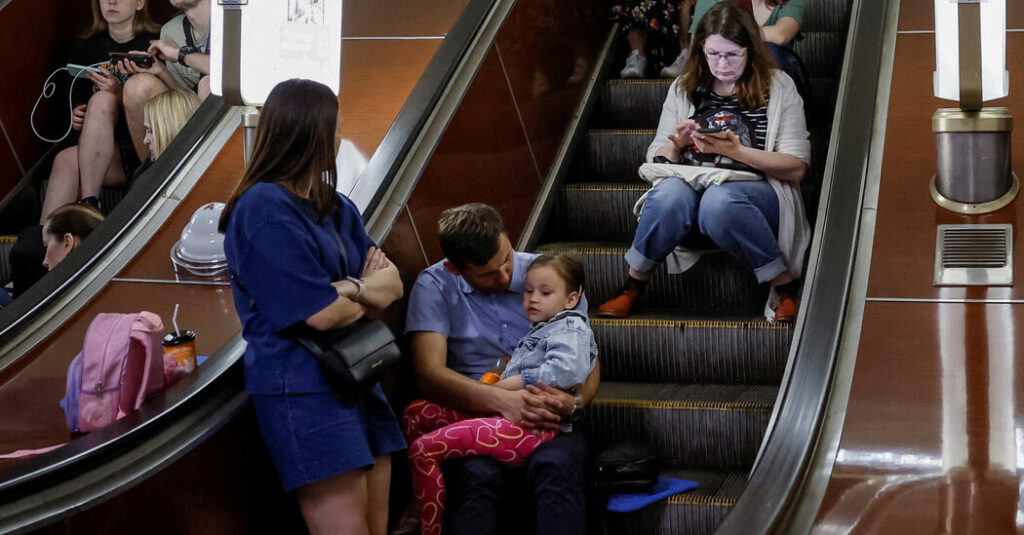Waves of strikes on Kyiv
Russia unleashed three attacks in 24 hours on the Ukrainian capital, Kyiv, culminating in explosions early this morning that killed at least one and prompted evacuations. At least three people were injured. It was not immediately clear whether the damage was from the debris of intercepted attacks or from direct hits by the drones.
The attack came after a barrage of 11 ballistic missiles around midday yesterday, sending residents racing for cover. Though all 11 missiles were quickly shot down, the attack was a grim reminder that while the front line may be hundreds of miles to the east, the Ukrainian capital of 3.6 million still has a Russian bull’s-eye on it.
Even as Kyiv, aided by Western allies, builds up its air defense system, Russian forces are intent on testing it for soft spots. They have changed the timing of bombardments, the combination of weapons used and the trajectories of missiles and drones, lately flying them low along riverbeds and through valleys to avoid detection, Ukrainian officials say.
Targets: Russian officials have often denied aiming at civilian areas. They said the strikes on Monday had been destined for air bases, and Ukrainian officials said Moscow did hit at least one military installation, damaging an airfield in Khmelnytskyi, in western Ukraine.
Spanish voters will go to the polls in July
Spain’s prime minister, Pedro Sánchez, said that he would dissolve Parliament and called a snap election for July 23, after his liberal Socialist Workers’ Party suffered bruising defeats in regional and local elections over the weekend. “I take personal responsibility for the results,” he said.
The announcement ends the country’s first coalition government since the return of democracy in the 1970s — a fragile alliance formed in 2020 from a hodgepodge of leftist parties and deeply polarizing Catalan and Basque separatists.
In the weekend’s elections, the Socialist Workers’ Party was crushed by the conservative Popular Party. The far-right Vox party — still taboo to many moderates — also performed well and is now represented in all of the country’s regional parliaments.
Legacy: Sánchez has overseen an economic growth rate above the E.U. average and given Spaniards relatively low power prices despite Europe’s energy crisis. But conservatives found fertile ground in his dependence on his coalition’s separatists and far-left forces, and they characterized him as being “in the hands of radical people,” one analyst said.
Details of debt limit deal emerge
The full legislative text of Speaker Kevin McCarthy’s debt limit agreement in principle with President Biden includes a two-year suspension of the debt ceiling, allowing the government to borrow as much money as it needs to pay its bills during that time period — as long as Congress passes the agreement before June 5, when the U.S. is forecast to run out of cash.
In exchange for suspending the limit, Republicans demanded a range of policy concessions, including limits on the growth of federal discretionary spending over the next two years and some new work requirements for certain welfare recipients. Both sides agreed to modest efforts meant to accelerate the permitting of some energy projects.
Under the new legislation, the debt limit will be set at whatever level it has reached when the suspension ends in 2025. For political reasons, Republicans tend to prefer suspending the debt limit rather than raising it, because it allows them to say they did not technically green-light a higher debt limit.
Details: The bill cuts spending on so-called nondefense discretionary, which includes domestic law enforcement, forest management, scientific research and more, for the 2024 fiscal year. It would limit all discretionary spending to 1 percent growth in 2025, which is effectively a budget cut, because that is projected to be slower than the rate of inflation.
THE LATEST NEWS
Around the World
After a van Gogh painting sold at auction, a movie producer claimed to be the winning bidder. The picture later vanished from sight, with a trail leading to Caribbean tax havens and a jailed billionaire who had been one of the most influential tycoons of China’s gilded age. The painting’s location is now unknown.
SPORTS NEWS FROM THE ATHLETIC
If Chelsea buys into its new coach’s vision, the sky is the limit: The soccer club’s incoming boss, Mauricio Pochettino, will look to build a culture where none currently exists.
The summer transfer outlook for members of the U.S. men’s national team: Where will Christian Pulisic, Tyler Adams and Yunus Musah end up?
What Formula 1’s Monaco Grand Prix taught us about 2023: What does the race mean in the context of the season so far and looking ahead? Here are five takeaways.
TIPS FROM WIRECUTTER
Stop misplacing everything
How do you keep track of your keys, phone, tools, notebooks, jacket — and everything else? Assuming this is general forgetfulness and not a sign of a more serious neurological issue or aging-related cognitive decline (if you suspect it is, please see a doctor for medical advice), these tricks from Wirecutter might help.
Give your stuff a home. The idiom goes, “a place for everything and everything in its place.” Not only do your things need somewhere to go, they also need to be returned to that spot after you’re finished using them. One idea: Hang your keys from an entryway key rack, and add small carabiners or clips to other objects so they can be hung there as well.
Track your objects. Bluetooth trackers can be used to find tools, keys, remotes and water bottles (the devices are water-resistant). You can even use them to locate your car. The smallest among them can fit onto the stem of a pair of eyeglasses, making them a great option for forgetful spectacle wearers.
Eliminate or adjust the often-lost item. Always forgetting your keys? Try a keyless smart lock. Can’t keep track of your notebook? Consider downsizing, or simply switching to the Notes app on your phone.


